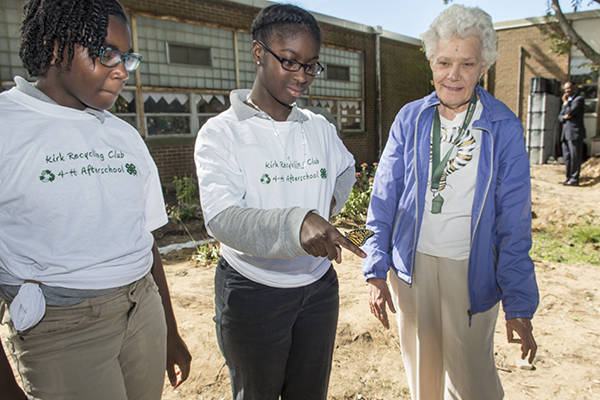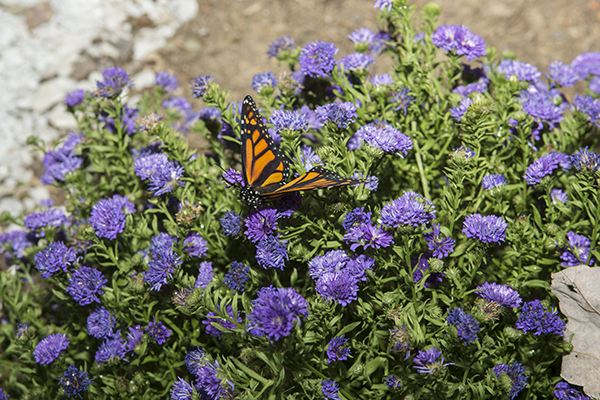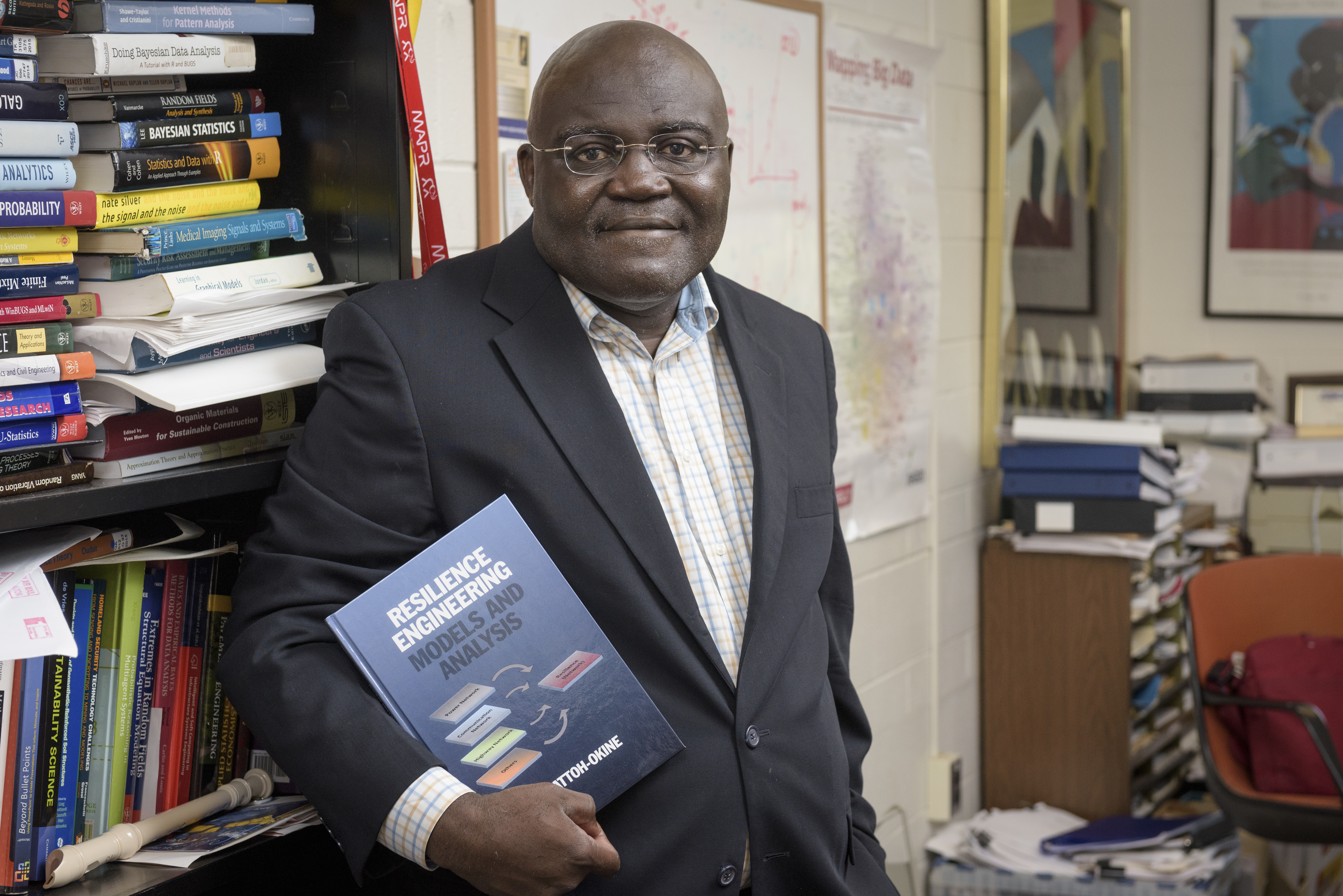


Monarch Waystation
UD Cooperative Extension helps launch butterfly garden at Kirk Middle
3:12 p.m., Oct. 7, 2014--Three monarch butterflies traveling to Mexico for the winter got their trip started on Tuesday, Sept. 23, at the dedication ceremony for Kirk Middle School’s newly installed Monarch Waystation.
The Monarch Waystation was created with the assistance of University of Delaware Cooperative Extension Master Gardeners Peg Baseden, Ellen Hahn, Fred Mann and Gil Martin, who provided support to the Delaware 4-H Afterschool Program’s Recycling Club.
People Stories
'Resilience Engineering'
Reviresco June run
Fontella Taylor, an extension educator and site director for the 4-H Afterschool Program at Kirk, Gauger-Cobbs and Shue-Medill middle schools, explained that the Monarch Waystation helped bring together many parts of Cooperative Extension.
“4-H is a huge part of Cooperative Extension. It was great to partner with Carrie Murphy, an Extension educator in horticulture who coordinates the Master Gardeners who came out to help with the butterfly garden,” Taylor said. “They helped design the garden, select appropriate plants, and show the kids how to plant and maintain a garden.”
Taylor added that once the 4-H Afterschool Recycling Club gets a composting project off the ground, she is hoping to partner with Cooperative Extension Master Food Educators to teach the group about healthy living and eating.
Monarch Waystation
The Monarch Waystation features all native vegetation, particularly milkweed and nectar plants that were donated to the school.
“We emphasized using native plants to Delaware and the milkweed is for the larval stage, or the caterpillar stage. The nectar plants are for the adult stage,” said Mann, who graduated from UD with a degree in entomology. “The caterpillar has chewing mouth parts to chew the leaves and the butterfly adult has a straw-like mouth part that goes into the flower and sucks up the nectar.”
Hahn said the Master Gardeners are trying to put milkweed into every garden they can because the monarch butterfly population has decreased so significantly.
“The monarch population has decreased to the point where, while the monarchs will not go extinct, people think that the migration will. The reason that the monarchs are in trouble is that there is so much less milkweed than there used to be,” said Hahn.
To track migration, the butterflies released at the school were all tagged under their wings so that when they are found, they can be catalogued by the Monarch Watch organization to show how far they traveled.
“You put these little tags on the underside of their wings and there’s a number we record when we release it,” Mann said. “We record whether the butterfly is male or female, where we released it from and the date, and then that’s put into a database. Whoever finds the butterfly can go back, look at the number and email Monarch Watch.”
Hahn said that the monarch butterflies usually travel to Mexico for the winter, an amazing 2,000-mile journey for a creature that weighs about the same as a paper clip.
“In the spring, they start the return journey and the first generation gets to maybe northern Mexico or Texas, where they lay eggs and then die. It takes about three generations for monarchs to arrive back here and it’s usually in June,” said Hahn.
Hahn has been to the sanctuary in Mexico where the monarchs travel for the winter, and said that the site has to be seen to be believed.
“It’s just an unbelievable experience. It’s very high in the mountains and it’s just the right climate so that they kind of go into almost a torpor. They expend very little energy and they winter there in these huge bundles, bundles that I just can’t even describe, thus the reason that we don’t want to lose the migration,” said Hahn.
Mann said that to get an idea of what the sanctuaries look like, one simply has to look up at a tree full of leaves. “They actually look like leaves because they’re so dense. Look up at a tree’s leaves and pretend they’re all butterflies, that’s how dense they are,” said Mann.
4-H Afterschool
The Monarch Waystation is just one of many improvements made to the courtyard area of Kirk thanks to the 4-H Afterschool Program’s Recycling Program at the school.
The area has chickens, a tool shed, six raised garden beds and a compost area.
Jackie Kook, who teaches the agriscience program at Kirk, said students learn a lot by getting hands-on experience with the plants and the animals in the courtyard.
“The kids totally transform when they come out here. I’ve seen not just my students, but students with other teachers as well, and being out here is such a treat,” Kook said. “They love to watch the animals, they want to hold and interact with the animals, and our chickens are layer hens so they produce eggs that we give to the 4-H Afterschool Family and Consumer Science program for their cooking labs.”
The idea to add a Monarch Waystation came about when Helene Ross, who teaches the Recycling Program with Kook, read about them on the Monarch Watch website.
Ross connected with Master Gardeners who came out to do a site assessment and give instructions on where to construct the garden. The students, with the help of Master Gardeners, then started building the garden in April.
Ross said that now that the garden has been installed, students in the Recycling Club will do a research project on the monarchs.
“Since we have the monarch butterfly garden, the kids just started doing research on the butterflies. They looked up the information on life cycles, and they’re going to look at some data on how many butterflies have been affected, where the milkweed has lessened in the United States, and try and tie the research in with the garden,” said Ross.
Article by Adam Thomas
Photos by Doug Baker









